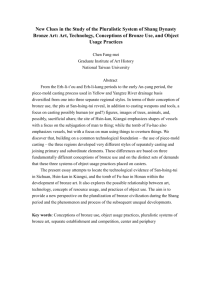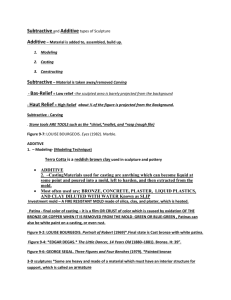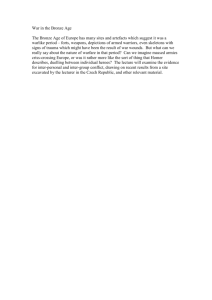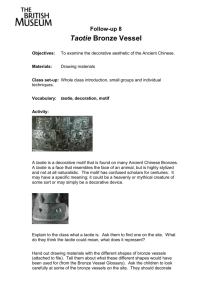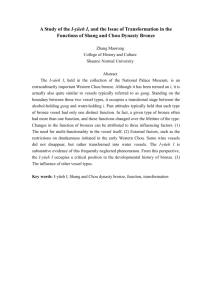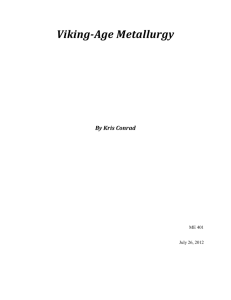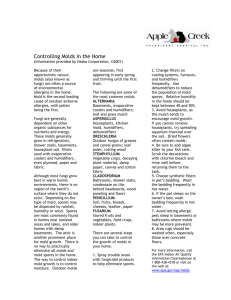Development of clay mold-making technology for bronze cast
advertisement
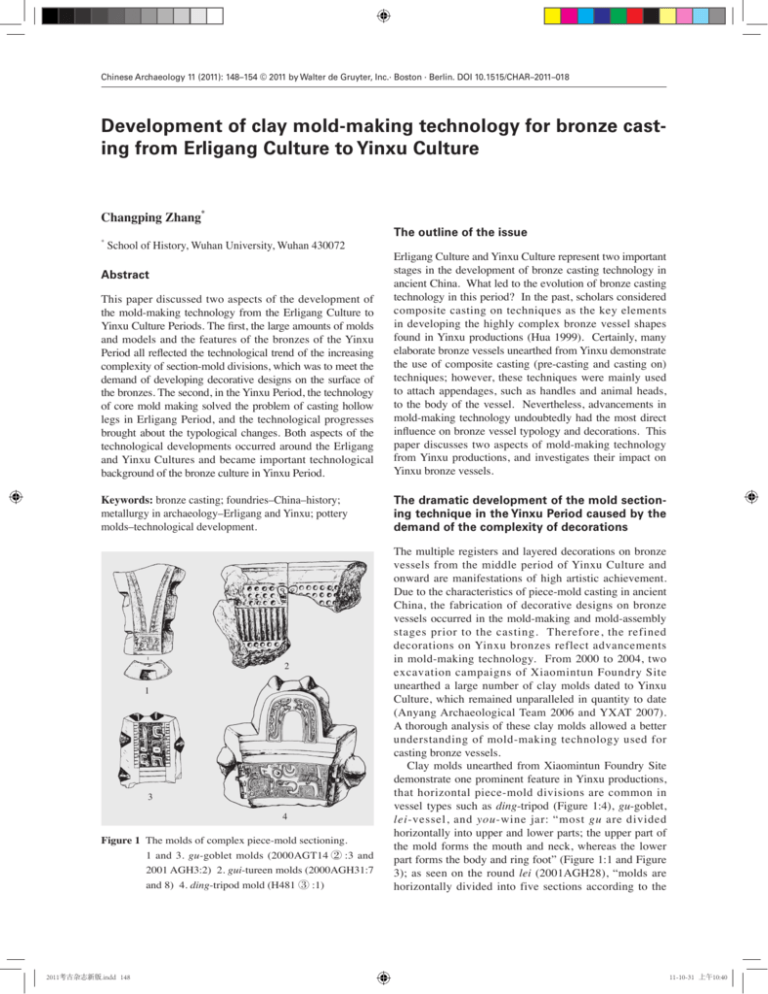
Chinese Archaeology 11 (2011): 148–154 © 2011 by Walter de Gruyter, Inc.· Boston · Berlin. DOI 10.1515/CHAR–2011–018 Development of clay mold-making technology for bronze casting from Erligang Culture to Yinxu Culture Changping Zhang* * School of History, Wuhan University, Wuhan 430072 The outline of the issue This paper discussed two aspects of the development of the mold-making technology from the Erligang Culture to Yinxu Culture Periods. The first, the large amounts of molds and models and the features of the bronzes of the Yinxu Period all reflected the technological trend of the increasing complexity of section-mold divisions, which was to meet the demand of developing decorative designs on the surface of the bronzes. The second, in the Yinxu Period, the technology of core mold making solved the problem of casting hollow legs in Erligang Period, and the technological progresses brought about the typological changes. Both aspects of the technological developments occurred around the Erligang and Yinxu Cultures and became important technological background of the bronze culture in Yinxu Period. Erligang Culture and Yinxu Culture represent two important stages in the development of bronze casting technology in ancient China. What led to the evolution of bronze casting technology in this period? In the past, scholars considered composite casting on techniques as the key elements in developing the highly complex bronze vessel shapes found in Yinxu productions (Hua 1999). Certainly, many elaborate bronze vessels unearthed from Yinxu demonstrate the use of composite casting (pre-casting and casting on) techniques; however, these techniques were mainly used to attach appendages, such as handles and animal heads, to the body of the vessel. Nevertheless, advancements in mold-making technology undoubtedly had the most direct influence on bronze vessel typology and decorations. This paper discusses two aspects of mold-making technology from Yinxu productions, and investigates their impact on Yinxu bronze vessels. Keywords: bronze casting; foundries–China–history; metallurgy in archaeology–Erligang and Yinxu; pottery molds–technological development. The dramatic development of the mold sectioning technique in the Yinxu Period caused by the demand of the complexity of decorations Abstract 2 1 3 4 Figure 1 The molds of complex piece-mold sectioning. 1 and 3. gu-goblet molds (2000AGT14 ② :3 and 2001 AGH3:2) 2. gui-tureen molds (2000AGH31:7 and 8) 4. ding-tripod mold (H481 ③ :1) 2011考古杂志新版.indd 148 The multiple registers and layered decorations on bronze vessels from the middle period of Yinxu Culture and onward are manifestations of high artistic achievement. Due to the characteristics of piece-mold casting in ancient China, the fabrication of decorative designs on bronze vessels occurred in the mold-making and mold-assembly stages prior to the casting. Therefore, the refined decorations on Yinxu bronzes reflect advancements in mold-making technology. From 2000 to 2004, two excavation campaigns of Xiaomintun Foundry Site unearthed a large number of clay molds dated to Yinxu Culture, which remained unparalleled in quantity to date (Anyang Archaeological Team 2006 and YXAT 2007). A thorough analysis of these clay molds allowed a better understanding of mold-making technology used for casting bronze vessels. Clay molds unearthed from Xiaomintun Foundry Site demonstrate one prominent feature in Yinxu productions, that horizontal piece-mold divisions are common in vessel types such as ding-tripod (Figure 1:4), gu-goblet, lei-vessel, and you-wine jar: “most gu are divided horizontally into upper and lower parts; the upper part of the mold forms the mouth and neck, whereas the lower part forms the body and ring foot” (Figure 1:1 and Figure 3); as seen on the round lei (2001AGH28), “molds are horizontally divided into five sections according to the 11-10-31 上午10:40 Ch. Zhang: Development of clay mold-making technology for bronze casting from Erligang Culture to Yinxu Culture mouth and neck, shoulder, upper and lower parts of the body, and round foot (Anyang Archaeological Team 2006)”. Since most bronze vessels are round in shape, vertical division is the mainstream for sectioning molds. Horizontal piece-mold divisions multiply the number of outer molds; for instance, a round ding with three vertically-divided outer molds will become six sections if the molds are divided once horizontally. On the other hand, complexity of piece-mold divisions in the vertical orientation is also observed on clay molds unearthed from Xiaomintun Foundry Site. In general, if a round ding or lei has three sets of decorations, and three vertical seams dividing the three sets of decorations, then the outer mold of this vessel is inferred to have been vertically sectioned into three. However, on many clay molds from Xiaomintun Foundry Site, more vertical seams are present within the same set of decorations. For instance, on the decorative design located on the upper body of a gui-tureen (2000AGH31:7), there is a vertical mold seam that goes through the center of the animal head (Figure 1:2). Since an animal head is usually placed along the central axis of a set of decorations, a vertical mold line bisecting the animal head indicates that the number of vertically-divided mold sections is doubled. On the crotched ding (T1907 ⑦ :1 and 2), the outer molds are divided vertically along the three legs, but also along the three crotches, making a total of six vertically-oriented mold sections. In fact, complex piece-mold divisions in both horizontal and vertical orientations were often used together. For instance, the round lei (2001AGH28) has six vertically-divided outer molds, in addition to being divided horizontally into five sections as described above. The outer molds of the ding (H481 ③ :1) are “divided along the flanges into six vertical sections, then divided on the upper part of the body into two horizontal sections (YXAT 2007, see Figure 1:4)”. Complexity of piece-mold divisions in vertical and horizontal orientations multiplied the number of outer molds required for casting a bronze vessel, which not only increased the workload of mold-makers, but also the difficulty of mold-assembly prior to casting. For instance, excluding molds for casting ears and handles, the round lei (2001AGH28) required 30 outer mold sections just for casting the vessel’s body. The reason for using complex piece-mold divisions becomes evident when such molds are compared to simple mold sections unearthed from Xiaomintun Foundry Site. A few mold sections of gu unearthed from the site are “vertically divided into two sections, without a horizontal division” (Anyang Archaeological Team 2006), such as the molds for gu (03AXST1907 ④ :27) are in two sections for the upper part of the vessel (Figure 2:1). In comparison, the majority of molds for gu unearthed from Xiaomintun are in four sections. The two outer molds of this particular gu (03AXST1907 ④ :27) lack the banana leaf design found on the gu molds that are divided into four sections. On the latter examples, the location of the banana leaf design corresponds to the mold joins (Figure 1:1 and 2011考古杂志新版.indd 149 149 1 2 3 Figure 2 The molds of simple piece-mold sectioning. 1. gu-goblet molds (03AXST1907 ④ :27) 2 and 3. ding-tripod molds (03AXSH573 ③ :53 and PNM52:1) 11-10-31 上午10:40 150 Ch. Zhang: Development of clay mold-making technology for bronze casting from Erligang Culture to Yinxu Culture 1 2 Figure 3 The complex piece-mold sectioning of the gugoblet (M60:2) in Huayuanzhuang Locus East. 2011考古杂志新版.indd 150 Figure 3), thus suggesting that complex piece-mold divisions were developed to meet the production demands for casting elaborate decorations. Similarly, a few ding unearthed from Yinxu have simple vessel forms. The mold for the round ding (03AXSH573 ③ :53) is divided vertically along the handles and the legs (Figure 2:2), thus comprising one bottom mold and three outer molds; the mold used for ding (03AXSH573 ③ :53) only has one register of dragon design and banana leaf design. This type of simple piece-mold division is also found on two outer molds of a ding (PNM52) unearthed from Yinxu, both of which only have a narrow band of whirl pattern in one register. Complex piece-mold division methods are not evident on the molds used for both ding because they lack densely-filled decorations on the body. In addition, both ding are relatively small in size – the molds for PNM52 indicate that the vessel is less than 20cm high – therefore, the limited quantity of sections in the mold assembly corresponds well to the dimensions of decorations that occupy a relatively small area of the vessel’s body. Illustrated by molds unearthed from Xiaomintun Foundry Site, those made by complex piecemold divisions generally contain intricate or layered decorations. In effect, complex division of molds reduces the spacing between mold sections and reduces the curvature of each mold section, which is favorable in two ways: smaller mold sections can improve the success rate of taking the impression of decorative designs directly from the model, while preserving the sharpness of the impressions which in turn produce a better cast in bronze. This trend of increasing complexity of piece-mold divisions for the sake of casting elaborate decorations on the surface of the bronzes occurred around the first phase of the Yinxu Culture. Two gu unearthed from Huayuanzhuang Locus East M60 have a bowstring pattern encircling the body, above which there is no decoration; however, below the bowstring pattern are two registers of dense and intricate patterns that form two sets of taotie design. Mold seams are clearly visible on the gu: the one between the two sets of taotie design starts at the mouth of the vessel and continues to the bottom (Figure 3:1); in addition, immediately below the bowstring pattern, two vertical mold seams follow the convex curves of the nose on the taotie design, and terminate at the ring foot (Figure 3:2). Therefore, it is evident that these two gu have a horizontal piece-mold division that corresponds to the location of the bowstring pattern: the upper part of the gu has two outer molds, whereas the lower part is divided into four outer molds. There is no decoration on the two outer molds forming the upper part of the vessel, whereas on the lower part, the mold divisions between the four outer molds correspond to the location of decorative designs, thus illustrating that the purpose of complex piece-mold divisions is to meet the production needs for casting complex decorations of the bronzes. In order to enhance the surface ornamentation of the bronzes, the onset of changes in mold-making and moldassembly technology occurred at least in the early Yinxu 11-10-31 上午10:40 Ch. Zhang: Development of clay mold-making technology for bronze casting from Erligang Culture to Yinxu Culture Culture. Ultimately, these technological advancements laid the groundwork for producing elaborate decorations on bronzes that peaked in the middle period of Yinxu Culture. In this light, the increased complexity of the bronze production process resulted from Shang craftsmen’s aspirations for achieving higher artistic expressions of the bronzes, which were closely related to the nature of ancient Chinese bronzes as ritual vessels. The evolutions of the bronze modeling features caused by the progresses of the bronze casting techniques One major distinction in Chinese bronze typology produced in Erligang Culture and Yinxu Culture is that the legs of a vessel evolved from being hollow to solid. In Erligang Culture, the interior of bronze cookware, such as ding, yan-steamer, li-cauldron and wine-drinking vessels, such as jia, is connected to the cavity inside each leg that continues down to the leg’s tip. Hollow-cast legs were inconvenient for cooking and holding food; however, if the legs were cast solid, the cooling process of a large mass of molten bronze might lead to casting defects. Therefore, the hollow-leg vessel typology should be the result of technical limitations in the casting process rather than an intentional choice in the vessel’s design. Ding and jia unearthed from Fu Hao Tomb commonly have solid legs, each containing an internal core, namely, a core mold made of clay that is encapsulated by the molten bronze during casting and remains inside the finished vessel. The use of internal cores allowed the legs to be solid but not entirely made of bronze; in effect, internal cores separated the vessel’s interior cavity from the legs, and avoid the structural defects caused by casting the legs in solid metal. Internal cores were still employed in casting legs and ears of bronze vessels in the late period of Yinxu Culture, to the later Warring States Period, Qin and Han Dynasties. From a design perspective, using internal cores to cast solid vessel legs posed some technical challenges in mold assembly: each internal core needed to be secured in place but in suspension between the outer molds, so that the molten bronze could fill in the space between the internal core and the outer molds. In the past, scholars observed that a difference in the typology of bronze vessels occurred after internal cores were employed during casting; however, the formation of this technique was not fully understood. An Figure 4 investigative study of the round ding and jia sheds light on how internal cores developed. In Erligang Culture, round ding all have hollow conical legs (Figure 4:1). A ding 2011考古杂志新版.indd 151 151 has three outer molds that join at the three legs, and all three seams meet at the center of the vessel’s underside, forming a Y-shaped seam joint (Figure 5:1). After internal cores came into use in the second phase of Yinxu Culture, all ding have solid cylindrical legs that correspond to a change in mold typology, namely, the space between the three legs is defined by a triangular bottom mold (Figure 5:3). Almost all of the 26 round ding unearthed from Fu Hao Tomb have a bottom mold (Hua 1999), illustrating that the technology for making this type of mold was highly mature. Based on the changes in mold typology described above, the use of internal core in vessel legs should have originated in the period between the middle of Shang Culture to the second phase of Yinxu Culture. A formal analysis of the legs on round ding vessels unearthed from representative sites dated to the middle of Shang Culture and the second phase of Yinxu Culture reveals several steps in the development of the internal core technique. Ding from sites such as Huanbei Shang City M10 and Xiaotun M388 have hollow legs whose interior cavity is connected to the interior of the vessel (Figure 4:2). However, compared to a ding from Erligang Culture, the ones from these later sites demonstrate an initial attempt to close off the cavity of the legs from 1 2 3 4 The formation of the internal core in the legs of the ding-tripod. 1. C8M2:4 in Zhengzhou Shang City 2. M388R2054 in Xiaotun, Yinxu 3. M60:1 in Huayuanzhuang Locus East, Yinxu 4. M1:2 in Wuguan Cemetery, Yinxu 11-10-31 上午10:40 152 Ch. Zhang: Development of clay mold-making technology for bronze casting from Erligang Culture to Yinxu Culture the vessel’s interior: each leg’s cavity is filled with clay, but a divot is present on the clay fill near the area where each leg joins to the vessel’s body. On the ding Huayuanzhuang Locus East M60:1, the legs are not entirely closed off, but the clay filling in each leg’s cavity is flush with the bottom of the vessel’s interior; in addition, the legs have the shape of a frustum close to cylindrical. As seen on two ding unearthed from Xiaotun M331R2051 and Wuguan M1, the top of the legs are completely sealed from the interior of the ding (Figure 4:4), indicating that the technique of using internal cores was fully mature in this period. In order to secure the internal core between the outer molds while remaining in suspension, internal cores generally have built-in struts. Unearthed from Xiaomintun Foundry Site, internal cores 1 used to make ding legs all have wedge-shaped struts protruding from the sides of the core; the height of the struts is equivalent to the thickness of the leg’s walls after casting. Detection of struts generally relies on x-ray as the wedge-shaped struts are not easily detectable visually; nevertheless, larger struts may still be visible on the vessel’s surface (Figure 6:2). Legs of larger ding from the late period of Yinxu Culture often have orifices on the sides, corresponding to the location of the struts. From the conical hollow legs, to frustum-shaped legs filled with clay, and finally, to near-cylindrical solid legs, stages of developing the internal core technique generally correlate to the date of the sites where the ding was unearthed. Therefore, the definitive period in which the internal core technique fully matured corresponds to the second phase 2 3 Figure 5 The mold-assembly modes of the ding-tripods in the Shang Culture Period. 1. Erligang Culture Period 2. the first phase of Yinxu Culture in the Middle Shang Dynasty 3. Late Yinxu Culture Figure 6 The internal core and core struts of the legs of ding and jia. 1. side-view of the internal core of ding leg (03AXST2206H232) 2. the inner side of ding leg (Guojiazhuang M160:32) 3. side-view of the jia leg (Wuguan M1:4) 2011考古杂志新版.indd 152 11-10-31 上午10:40 Ch. Zhang: Development of clay mold-making technology for bronze casting from Erligang Culture to Yinxu Culture 1 2 3 153 4 Figure 7 The formation of the internal core in the legs of the jia. 1. Zhengzhou Shang City C9:Zhengzhou Museum 0156 2. Xiaotun M333R2045 3. M60:8 in Huayuanzhuang Locus East 4. HPKM1400R1115 of Yinxu Culture, which is the date of the Wuguang M1 site. The use of internal cores for legs of jia followed the same development as ding. In addition to jia type in which the hollow legs are connected to the vessel’s interior (Figure 7:1), there are two types of jia in which the legs are completely sealed off, but the legs either have a T-shaped or triangular cross-section (Figure 7:2). In the latter type, grooves are present on the two inner sides of each leg, and each leg contains an internal core (Figure 7:4). Since the jia with hollow legs and legs with T-shaped cross-section usually coexisted in the tombs such as Xiaotun M333 and M388, scholars have long assumed that the type of jia with T-shaped cross-sections represented a later phase in the technological development (Li 1968). Judging from the mold examples unearthed in recent years, the chronology of the typological development of jia becomes evident: jia dated to Erligang Culture have hollow legs, whereas those dated to the middle and late phases of Yinxu Culture, as represented by Fu Hao Tomb, have legs with triangular cross-sections which are completely sealed from the vessel’s interior. From a technological perspective, jia whose legs have T-shaped cross-sections represent the transitional period between the two phases described above, serving as an attempt to separate the hollow inside the legs and the vessels’ interior before the introduction of the internal core technique. The legs of jia (Xiaotun M333R2045) have a simpler form of T-shape cross-section (Figure 7:2), and jia appearing thereafter have legs that are filled with clay. The legs of jia (Huayuanzhuang Locus East M60: 8) unearthed from Xiaotun M331 also have T-shaped crosssections (Figure 7:3), but with wider walls in bronze that almost enclose the two sides of the T-shape. The legs 2011考古杂志新版.indd 153 of jia (Wuguang M1) have triangular cross-sections that completely enclose the internal core; in addition, the sides of the leg have orifices corresponding to the location of core struts on the internal core (Figure 6:3). Therefore, the formation of internal core technique used in casting bronzes in ancient China is exemplified by the typological changes observed on the legs of jia, moving from legs with T-shaped to those with triangular cross-sections, which also corresponds to the internal core technique used for the legs of ding in terms of conceptual and technological development. The interactive developments of the bronze casting techniques and the modeling and decorating features The typology and consequent modifications in forms of ancient Chinese bronze vessels, especially in the early Bronze Age, are intimately connected to the technological advancements in the production process. Some of the demands in vessel form prompted modifications in the production methodology; one example is that piecemold divisions became increasingly complex in order to meet the demands of producing elaborate decorations on the surface of the bronzes. On the other hand, some typological changes in a vessel’s form derived from developments in casting technology; for instance, after internal cores were introduced to the casting process, the legs of bronze vessels evolved from being hollow to solid. In essence, these two principles guided the development of Chinese bronze casting technology; techniques such as the use of metal spacers, internal cores, pre-casting and casting-on techniques continued to refine the production methodology. The impetus for developing complex piece- 11-10-31 上午10:40 154 Ch. Zhang: Development of clay mold-making technology for bronze casting from Erligang Culture to Yinxu Culture mold divisions and mold-assembly methods was to fulfill the nature of ancient Chinese bronzes as ritual vessels by enhancing the bronzes’ mass and embellish their aesthetic appearance. Serving as important technological foundation for the flourishing bronze production in Yinxu Culture, many of these technological advancements described above essentially occurred in the period between Erligang Culture to Yinxu Culture, and reached maturity in the early period of Yinxu Culture. References Anyang Archaeological Team, IA, CASS 中国社会科学 院 考 古 研 究 所 安 阳 工 作 队. 2006. 2000–2001 Nian Anyang Xiaomintun Dongnandi Yindai Zhutong Yizhi Fajue Baogao 2000–2001 年安阳孝民屯东南地殷代 铸铜遗址发掘报告 (Excavation of 2000–2001 on the Bronze Foundry-site of the Yin Period in the Southeast of Xiaomintun, Anyang). Kaogu Xuebao 考古学报 (Acta Archaeologica Sinica) 3: 351–84. Hua, Jueming 华觉明. 1999. Zhongguo Gudai Jinshu Jishu: Tong he Tie Zaojiu de Wenming 中国古代金属技术: 铜和 铁造就的文明 (Metallurgy in Ancient China). Zhengzhou: Daxiang Chubanshe. 2011考古杂志新版.indd 154 Li, Ji 李 济 and Wan Jiabao 万 家 保. 1968. Yinxu Chutu Qingtong Jiaxingqi zhi Yanjiu 殷虛出土青銅斝形器之 研究 (Studies of the Bronze Chia-vessel, Excavated from Hsiao T’un & Hou Chia Chuang; Its Casting Process and Decorative Patterns). [Taipei]: Zhongyang Yanjiuyuan Lishi Yuyan Yanjiusuo. pp. 16-7. Karlbeck, O. 1935. Anyang Moulds. Bulletin of the Museum of Far Eastern Antiquities 7: 39–60. Yinxu Xiaomintun Archaeological Team (YXAT) 殷墟孝民 屯考古队. 2007. Henan Anyang Shi Xiaomintun Shangdai Zhutong Yizhi 2003–2004 Nian de Fajue 河南安阳市孝 民屯商代铸铜遗址 2003–2004 年的发掘 (2003-2004 Excavation of a Shang Bronze Foundry-site at Xiaomintun in Anyang City, Henan). Kaogu 考古 (Archaeology) 1: 14–25. Postscript The original paper published in Kaogu 考古 (Archaeology) 2010. 8: 79–86, with seven illustrations and one table, was written by Zhang Changping 张昌平, Liu Yu 刘煜, Yue Zhanwei 岳占伟 and He Yuling 何毓灵. The abridged version is written by Zhang Changping and translated into English by Linda Ying-chun Lin 林盈君. 11-10-31 上午10:40
